The impressionist painters of the late 19th century changed the way we looked at the world, and in the case of Monet changed the way we looked at our gardens.
In 1883, Monet and his family moved to the village of Giverny, northwest of Paris. He found a house that had been part of a cider farm with an orchard that was to become his passion, both to paint and garden, until his death in 1926.
After his death, his stepdaughter Blanche managed both the house and garden, but after World War II both were found to be sadly deteriorated. Thanks mainly to generous donors, mostly from the United States, the gardens have been restored and we can all enjoy the timeless quality of Monet's vision.
Perhaps the most famous images of the garden are in Monet's series of water lily paintings; the setting is a pond he created by diverting the Ru River. There are many other elements we can take from the gardens at Giverny, though, especially the choice of plants and how they can be combined to create that Monet magic in our own gardens.
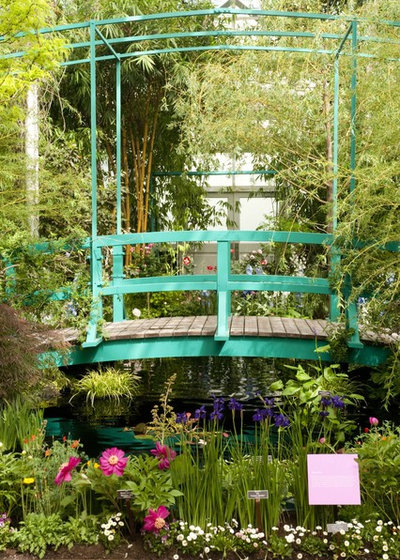
The New York Botanical Garden
The most iconic image of Monet's garden, seen in many of his most famous Giverny paintings, is the Japanese bridge. The original, inspired by Japanese woodblock prints that decorated Monet's house, was built by local craftsmen.
A reproduction of the bridge is now the centerpiece of The New York Botanical Garden's tribute to Monet. This celebration of Monet's gardens, including representations of his plantings, as well as the chance to see two rarely seen paintings by the artist, is on display until October 21, 2012.
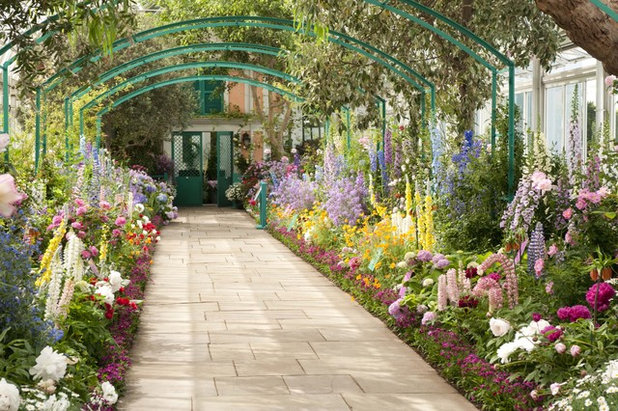
The New York Botanical Garden
Leading from Monet's house is the the central alley, here re-created in the Enid A. Haupt Conservatory at The New York Botanical Garden. The alley is the highlight of the garden in late summer and autumn.
Planting schemes of the early 20th century consisted of overabundant borders encased in boxwood
(Buxus spp.). Monet removed all the box edging from borders in the existing garden, allowing the free plants to stray onto the pathway. This veered from the structure and constraint of contemporary garden design at the time.
A clever trick he used when forming beds, and one easily copied in our own gardens, was to bank up the soil to make the plants seem taller.
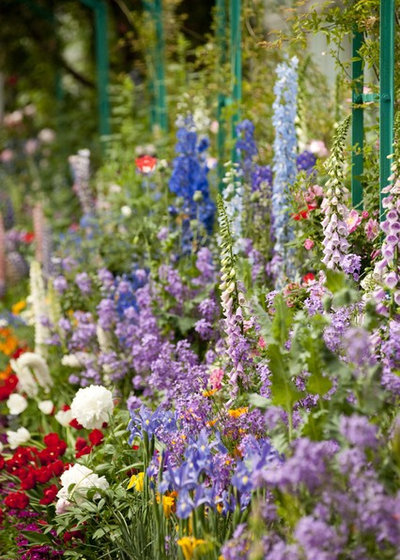
The New York Botanical Garden
While the original garden was planted with Japanese anemones, asters and nasturtiums, the re-creation is a celebration of pastels, with the spires of delphiniums, verbascums and lupins surrounded by blowsy peonies.
Monet's garden was without a doubt planted to his own taste. He didn't follow fashion and hated plants that he saw as "unnatural," such as variegated foliage.
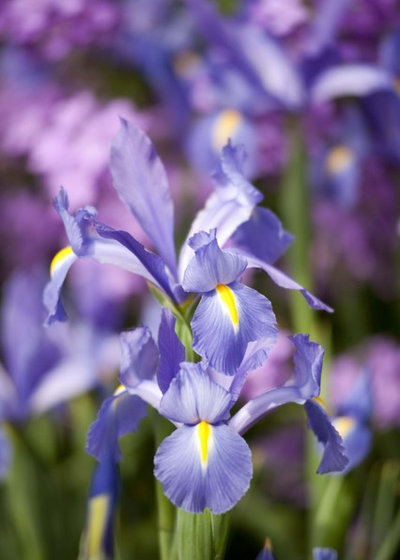
The New York Botanical Garden
Peeping out amongst the exuberant herbaceous blooms and foliage are the clean-cut flowers of Dutch iris
(Iris x hollandica), zones 5 to 9. Monet was passionate about mixing different types of plants, from the simplest wildflower to the most rare variety, as long as he acheived the effect he wanted.
Unlike the large rhizome-grown bearded iris, Dutch irises are evergreen and clump forming. They are easy to grow and great as cut flowers.
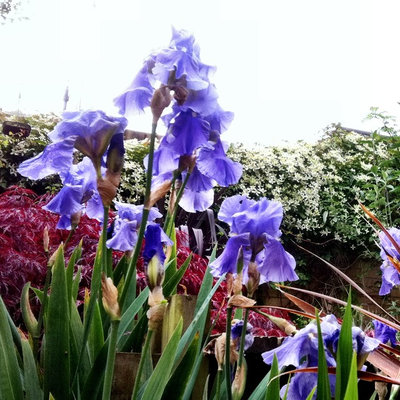
Perhaps the star of Monet's garden, especially during May and June, is the bearded iris (
Iris 'Germanica'),
zones 3 to 8
.He grew them in many colors and forms, but the most well known are the blues, violets, purples and whites. By growing early and late cultivars, Monet created a longer period of flowering, helped by the alkaline soil of Giverny.
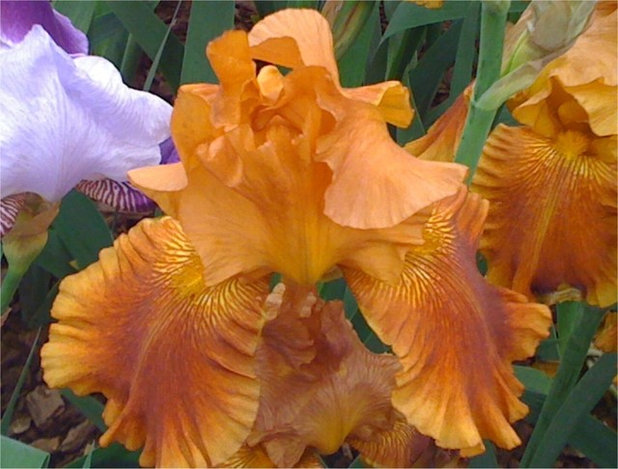
There are bearded irises to suit all sizes and styles of gardens, and as with Monet's garden, selection of differing cultivars can either extend the flowering season or give you a blaze of color just when you want it.
The season starts with the miniature dwarf bearded iris, which is the first to flower in April; it ends in late June or early July with tall bearded iris.
Growing tip: Most irises need well-drained soil in full sun. To keep these irises at their best they should be divided and replanted in July or August every two to three years. Any poor or diseased plants can be discarded, while the best are replanted.
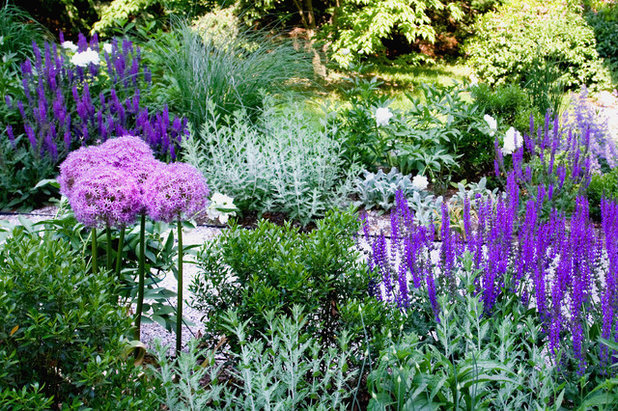
Matthew Cunningham Landscape Design LLC
One of the basic tenets of Monet's gardening was to create harmony in the plantings. We can see here how that idea has been used in a modern scheme, with the purple salvias blending beautifully with the globe-headed alliums.
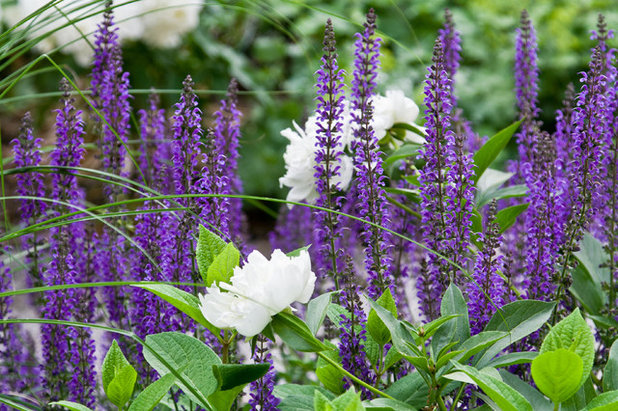
Matthew Cunningham Landscape Design LLC
But looking closer we see a further link to Monet, with the touch of white blooms to set off mauves and purples. It's a simple way to enliven monotone plantings and one that we find at Giverny, not only in borders of pastel plantings but also in some of the hot colors of late summer and autumn.
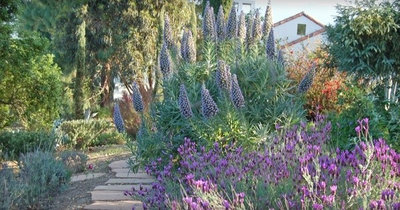
Aitken and Associates
It's not only the lush planting of herbaeceous perennials that can give us the atmosphere of a Monet border. We can see here how the use of Mediterranean plants in a dryer climate still fulfills the same functions: The Pride of Madeira
(Echium candicans), zones 9 to 10, takes the place of towering delphiniums, while the Spanish lavender
(Lavandula stoechas), zones 6 to 9, stands in for the lower plantings of lupins and nicotiana.
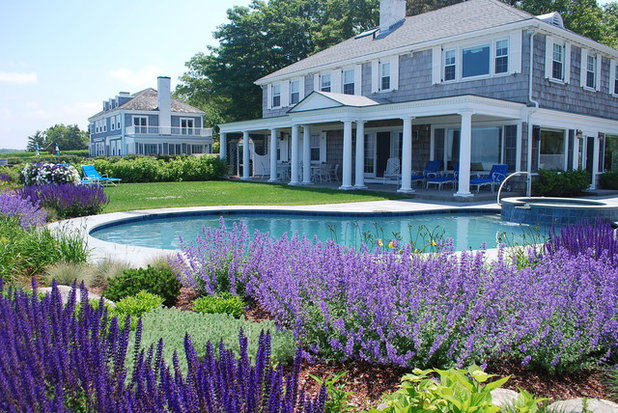
Elliott Brundage Landscape Design
Even in very modern, soft landscape design, we can bring a touch of Monet's planting palette. Here, drifts of May Night Salvia (
Salvia x sylvestris 'May Night'), zones 3 to 9, and Walker's Low Catmint (
Nepeta x faassenii 'Walker's Low'
), zones 3 to 8, are used to create a loose union of linking colors that roam quite freely — just as Claude Monet liked.
To see the real thing: Monet's Giverny garden is open daily from the begining of April through the end of October. Guided tours of the garden are available in English, French and German. There are local accommodations, or you can take a day trip by bus from Paris.
The New York tribute: See the exhibition at The New York Botanical Garden through October 21, 2012.
More:Focus Your Garden Palette
Lay of the Landscape: Natural Garden Style





